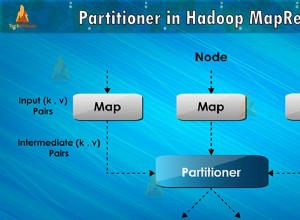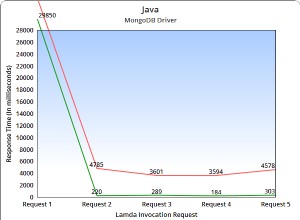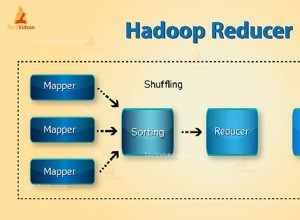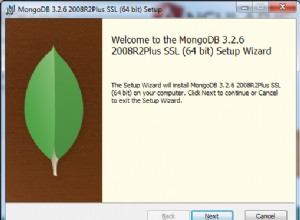Si usa Stackechange.Redis, puede usar los métodos List en su API. Aquí hay una implementación ingenua de IList usando una lista redis para almacenar los elementos.
Con suerte, puede ayudarlo a comprender algunos de los métodos API de la lista:
public class RedisList<T> : IList<T>
{
private static ConnectionMultiplexer _cnn;
private string key;
public RedisList(string key)
{
this.key = key;
_cnn = ConnectionMultiplexer.Connect("localhost");
}
private IDatabase GetRedisDb()
{
return _cnn.GetDatabase();
}
private string Serialize(object obj)
{
return JsonConvert.SerializeObject(obj);
}
private T Deserialize<T>(string serialized)
{
return JsonConvert.DeserializeObject<T>(serialized);
}
public void Insert(int index, T item)
{
var db = GetRedisDb();
var before = db.ListGetByIndex(key, index);
db.ListInsertBefore(key, before, Serialize(item));
}
public void RemoveAt(int index)
{
var db = GetRedisDb();
var value = db.ListGetByIndex(key, index);
if (!value.IsNull)
{
db.ListRemove(key, value);
}
}
public T this[int index]
{
get
{
var value = GetRedisDb().ListGetByIndex(key, index);
return Deserialize<T>(value.ToString());
}
set
{
Insert(index, value);
}
}
public void Add(T item)
{
GetRedisDb().ListRightPush(key, Serialize(item));
}
public void Clear()
{
GetRedisDb().KeyDelete(key);
}
public bool Contains(T item)
{
for (int i = 0; i < Count; i++)
{
if (GetRedisDb().ListGetByIndex(key, i).ToString().Equals(Serialize(item)))
{
return true;
}
}
return false;
}
public void CopyTo(T[] array, int arrayIndex)
{
GetRedisDb().ListRange(key).CopyTo(array, arrayIndex);
}
public int IndexOf(T item)
{
for (int i = 0; i < Count; i++)
{
if (GetRedisDb().ListGetByIndex(key, i).ToString().Equals(Serialize(item)))
{
return i;
}
}
return -1;
}
public int Count
{
get { return (int)GetRedisDb().ListLength(key); }
}
public bool IsReadOnly
{
get { return false; }
}
public bool Remove(T item)
{
return GetRedisDb().ListRemove(key, Serialize(item)) > 0;
}
public IEnumerator<T> GetEnumerator()
{
for (int i = 0; i < this.Count; i++)
{
yield return Deserialize<T>(GetRedisDb().ListGetByIndex(key, i).ToString());
}
}
System.Collections.IEnumerator System.Collections.IEnumerable.GetEnumerator()
{
for (int i = 0; i < this.Count; i++)
{
yield return Deserialize<T>(GetRedisDb().ListGetByIndex(key, i).ToString());
}
}
}
Tenga en cuenta el uso de Newtonsoft.Json para la serialización. Necesitará los siguientes paquetes nu-get:
Install-Package Newtonsoft.Json
Install-Package StackExchange.Redis
Después de leer tu pregunta y comentarios, ya que quieres acceder a los elementos por clave, creo que estás buscando Redis Hashes, que son mapas compuestos por campos asociados con valores.
Entonces puede tener una Clave Redis para un Hash que contenga a todos sus Clientes, siendo cada uno un Valor asociado a un Campo. Puede elegir CustomerId como campo, de modo que pueda obtener un cliente por su ID en O(1).
Creo que implementar IDictionary es una buena manera de verlo funcionar. Entonces, una clase RedisDictionary similar a RedisList pero usando Redis Hash podría ser:
public class RedisDictionary<TKey, TValue> : IDictionary<TKey, TValue>
{
private static ConnectionMultiplexer _cnn;
private string _redisKey;
public RedisDictionary(string redisKey)
{
_redisKey = redisKey;
_cnn = ConnectionMultiplexer.Connect("localhost");
}
private IDatabase GetRedisDb()
{
return _cnn.GetDatabase();
}
private string Serialize(object obj)
{
return JsonConvert.SerializeObject(obj);
}
private T Deserialize<T>(string serialized)
{
return JsonConvert.DeserializeObject<T>(serialized);
}
public void Add(TKey key, TValue value)
{
GetRedisDb().HashSet(_redisKey, Serialize(key), Serialize(value));
}
public bool ContainsKey(TKey key)
{
return GetRedisDb().HashExists(_redisKey, Serialize(key));
}
public bool Remove(TKey key)
{
return GetRedisDb().HashDelete(_redisKey, Serialize(key));
}
public bool TryGetValue(TKey key, out TValue value)
{
var redisValue = GetRedisDb().HashGet(_redisKey, Serialize(key));
if (redisValue.IsNull)
{
value = default(TValue);
return false;
}
value = Deserialize<TValue>(redisValue.ToString());
return true;
}
public ICollection<TValue> Values
{
get { return new Collection<TValue>(GetRedisDb().HashValues(_redisKey).Select(h => Deserialize<TValue>(h.ToString())).ToList()); }
}
public ICollection<TKey> Keys
{
get { return new Collection<TKey>(GetRedisDb().HashKeys(_redisKey).Select(h => Deserialize<TKey>(h.ToString())).ToList()); }
}
public TValue this[TKey key]
{
get
{
var redisValue = GetRedisDb().HashGet(_redisKey, Serialize(key));
return redisValue.IsNull ? default(TValue) : Deserialize<TValue>(redisValue.ToString());
}
set
{
Add(key, value);
}
}
public void Add(KeyValuePair<TKey, TValue> item)
{
Add(item.Key, item.Value);
}
public void Clear()
{
GetRedisDb().KeyDelete(_redisKey);
}
public bool Contains(KeyValuePair<TKey, TValue> item)
{
return GetRedisDb().HashExists(_redisKey, Serialize(item.Key));
}
public void CopyTo(KeyValuePair<TKey, TValue>[] array, int arrayIndex)
{
GetRedisDb().HashGetAll(_redisKey).CopyTo(array, arrayIndex);
}
public int Count
{
get { return (int)GetRedisDb().HashLength(_redisKey); }
}
public bool IsReadOnly
{
get { return false; }
}
public bool Remove(KeyValuePair<TKey, TValue> item)
{
return Remove(item.Key);
}
public IEnumerator<KeyValuePair<TKey, TValue>> GetEnumerator()
{
var db = GetRedisDb();
foreach (var hashKey in db.HashKeys(_redisKey))
{
var redisValue = db.HashGet(_redisKey, hashKey);
yield return new KeyValuePair<TKey, TValue>(Deserialize<TKey>(hashKey.ToString()), Deserialize<TValue>(redisValue.ToString()));
}
}
System.Collections.IEnumerator System.Collections.IEnumerable.GetEnumerator()
{
yield return GetEnumerator();
}
public void AddMultiple(IEnumerable<KeyValuePair<TKey, TValue>> items)
{
GetRedisDb()
.HashSet(_redisKey, items.Select(i => new HashEntry(Serialize(i.Key), Serialize(i.Value))).ToArray());
}
}
Y aquí hay algunos ejemplos para usarlo:
// Insert customers to the cache
var customers = new RedisDictionary<int, Customer>("customers");
customers.Add(100, new Customer() { Id = 100, Name = "John" });
customers.Add(200, new Customer() { Id = 200, Name = "Peter" });
// Or if you have a list of customers retrieved from DB:
IList<Customer> customerListFromDb;
customers.AddMultiple(customerListFromDb.ToDictionary(k => k.Id));
// Query a customer by its id
var customers = new RedisDictionary<int, Customer>("customers");
Customer customer100 = customers[100];
Actualización (octubre de 2015)
Se puede encontrar una mejor implementación de estas colecciones en la biblioteca CachingFramework.Redis.
Aquí está el código.




